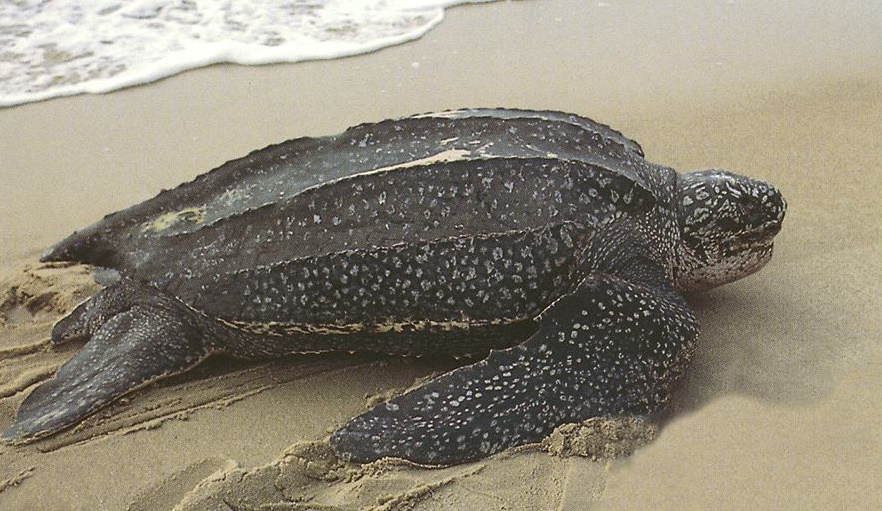

The species is solitary by habit, and perhaps the most migratory of all sea turtle species. Wild growth rates and age at maturity are unknown. Hatchlings enter the sea and immediately head for the open sea, very little is known about juvenile stages. Famously deep diving to forage and to escape predators is enabled in part by a moderately flexible carapace and plastron, and the capacity of blood and muscle tissue to hold relatively high amounts of oxygen (rather than storing it in the lungs). During non-reproductive seasons, adults range widely in search of soft-bodied sea jellies and salps, using three interlocking cusps to slice into their prey. Each nest contains an average of 70-90 large, yolked eggs in addition to a variable number of smaller, often misshapen yolkless eggs whose function has not been fully defined. Females migrate to mating and nesting grounds every two to three (or more) years, storing sperm throughout the nesting season and fertilizing as many as 12 clutches of eggs laid 9-10 days apart. Nesting grounds tend to be located on beaches adjacent to deep water (offshore reefs can injure the soft-skinned turtles). Nesting peaks between April and July in the southern Caribbean, home to the largest known nesting aggregations of leatherback turtles on earth. An unpigmented (pink) spot on the crown of the head – unique to each individual – may gauge day length and aid in migration. Adults lack head and flipper scales, and have no claws on their flippers. The carapace is composed of small osteodermic pieces (think “tiny little bones”) embedded in a thick matrix of cartilaginous dermal tissue as such, there are no scutes present on the shell. The species is unique among sea turtles in lacking a hard shell. Scientists believe that these ridges improve laminar flow and promote swimming efficiency.

The carapace is elongated and has seven ridges running its entire length, with six longitudinal ridges found on the plastron. The plastron is whitish, giving the animal a counter-shading effect. Carapace color ranges from black to dark brown, often with pink, white or bluish splotches. Largest of all turtles, adult males can exceed nine feet in length and weigh 2000 lb or more. The people of the Wider Caribbean know Dermochelys by a variety of common names, the most prevalent being leatherback in English, laud (or tora) in Spanish, and tortue luth in French.
#Leatherback seaturtle skin#
The binomial refers to the distinctive leathery, scaleless skin of the adult turtle. The specific name coriacea was first used by Vandelli (1761) and adopted by Linneaus (1766). A team of Conservancy staff work from March to October-nesting season-to ensure safe passage for hatchlings to return to the sea. Over the years, the program has successfully aided in the rescue and release of hundreds of turtles.The generic name Dermochelys was introduced by Blainville (1816). In Florida, the Conservancy’s Blowing Rocks Preserve is a popular breeding ground for many species of sea turtles, including leatherbacks. Virgin Islands to help protect turtles at Sandy Point. For example, TNC is working with the U.S. The Conservancy is partnering extensively with governments, local organizations and businesses around the world to help conserve leatherback turtles. The main threats facing the species are:Īccidental entanglement in fishing equipment The IUCN lists the leatherback as Critically Endangered, the Pacific and Indian Ocean populations in particular danger.

Sadly, the leatherback sea turtle leads other sea turtles in another category: the race to extinction. This diet fuels amazingly fast growth, 7 to 13 years to adult size. Unsuited to hunt much prey with its weak, scissor-like jaws, the turtle feeds primarily on jellyfish, which it stores and wrings of water in its extremely long esophagus. Unlike other sea turtles, the leatherback’s shell resembles hard rubber, which is advantageous in deep dives because it compresses, rather than shattering. The most distinctive features of the leatherback are its lack of scales, claws and horny shell. Is one of the widest ranging vertebrates, ranging from Newfoundland to Norway, from New Zealand to Argentina and South Africa. It also:Ĭan weigh, as an adult, as much as 1,300 poundsĬan dive as deep as a whale, around 4,000 feet The leatherback sea turtle is the largest and fastest turtle on earth.


 0 kommentar(er)
0 kommentar(er)
